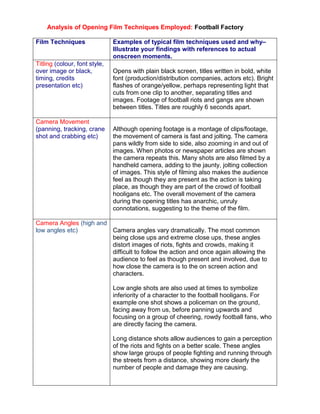
Analysis Of Opening Film Techniques Football Factory
- 1. Analysis of Opening Film Techniques Employed: Football Factory Film TechniquesExamples of typical film techniques used and why– Illustrate your findings with references to actual onscreen moments. Titling (colour, font style, over image or black, timing, credits presentation etc) Opens with plain black screen, titles written in bold, white font (production/distribution companies, actors etc). Bright flashes of orange/yellow, perhaps representing light that cuts from one clip to another, separating titles and images. Footage of football riots and gangs are shown between titles. Titles are roughly 6 seconds apart. Camera Movement (panning, tracking, crane shot and crabbing etc)Although opening footage is a montage of clips/footage, the movement of camera is fast and jolting. The camera pans wildly from side to side, also zooming in and out of images. When photos or newspaper articles are shown the camera repeats this. Many shots are also filmed by a handheld camera, adding to the jaunty, jolting collection of images. This style of filming also makes the audience feel as though they are present as the action is taking place, as though they are part of the crowd of football hooligans etc. The overall movement of the camera during the opening titles has anarchic, unruly connotations, suggesting to the theme of the film.Camera Angles (high and low angles etc)Camera angles vary dramatically. The most common being close ups and extreme close ups, these angles distort images of riots, fights and crowds, making it difficult to follow the action and once again allowing the audience to feel as though present and involved, due to how close the camera is to the on screen action and characters.Low angle shots are also used at times to symbolize inferiority of a character to the football hooligans. For example one shot shows a policeman on the ground, facing away from us, before panning upwards and focusing on a group of cheering, rowdy football fans, who are directly facing the camera.Long distance shots allow audiences to gain a perception of the riots and fights on a better scale. These angles show large groups of people fighting and running through the streets from a distance, showing more clearly the number of people and damage they are causing. Mise-en-scène (colour, figure, props, lighting, objects, location and setting;)Colour: the colours are dull and muted, if there at all. Much of the footage is filmed in black and white, giving the impression that it is footage taken from another source such as news reports or documentaries. A significant change in colour can be seen in the flashes of orange/yellow light that separates footage from titles. As we progress into the montage of violence and rioting the flashes move from the original bright colours to a deeper shade of red. This colour suggests danger, often related to blood and violence by audiences. Setting/location: the setting of each image is in a very urban area. The characters seen are often surrounded by brick walls, dully coloured buildings, police cars and helicopters, vans, flats and estates, football stadiums, CCTV cameras and abusive graffiti –all of which are stereotypical to the working class, urban genre. This reveals to audiences the type of area and people that will be focused on during the film.Props: props are difficult to distinguish in the chaotic news reel and hand held footage, we can see the police with protective weapons and shields, football shirts and scarves can also be distinguished, signifying that there is quarrel between different teams. Newspapers are also key to this opening as the camera focuses on newspaper articles and headlines that record events in which football hooligans have caused problems or riots. The camera focuses on headlines that dramatize the events, statements such as “rival fans clash” and “rabid supporters” inform the audience once again that there are opposing groups of people, as a result of supporting different teams and that they are radical in their actions.Sound techniques(diegetic, non diegetic, silence, dialogue) The sound does not vary, the same piece of music, Acid, Pt. 3 by Rennie Pilgrem, is used throughout the entire opening titles. The music is electronic; there is a repetitive low pulsing bass rhythm, that gradually increases to a climax can be linked to a heartbeat, increasing as a result of adrenaline. The music is fast, the high pitched, siren-like sounds involved in the piece clash against one another, starting off slow before the tempo pace quickens and a more powerful, deeper beat is introduced. The music is energetic, rapid and frenzied, coinciding with the theme of the film and footage being shown.